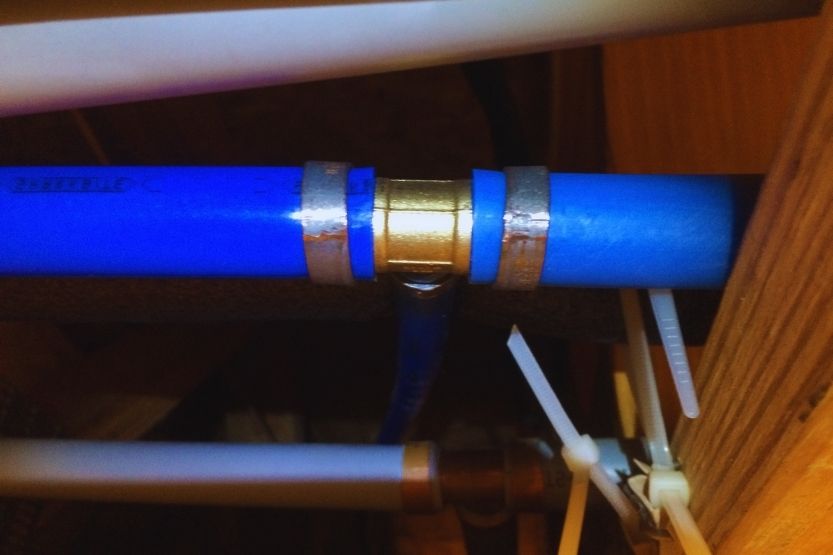Are you thinking of replacing your copper pipes at home with the more reliable and cost-effective Polyethylene cross-linked (PEX) pipes? Then find out what form of connectors is more suitable for your needs. In that case, you need to decide between PEX crimp vs clamp.
Both PEX crimp and clamp connections use similar fittings called “crimp” or “barbed.” These two methods require the use of different tools and types of rings. However, their styles are so alike that to the untrained eye, they look the same.
Both crimping and clamping create reliable seals if done correctly. This means choosing one over the other will solely depend on personal preference.
Read on to learn more about the differences between PEX crimp vs clamp. This article can also provide more information to help you choose which one to use on your house’s plumbing.
PEX Crimp Vs Clamp

Which one between PEX clamp vs crimp should you use for your new plumbing layout? Does crimping have significant advantages over clamping and vice-versa? Let’s discuss these two types to make an educated decision later:
PEX Crimping
Crimping is an older and more popular method of sealing PEX connections. Professionals and home DIY experts trust that PEX crimping tools will provide reliable and accurate seals.
These tools typically use copper rings to tighten the connections. There are also teeth in the rings to provide a firm seal on the PEX tubing. This will squeeze the copper ring around the PEX pipe to create a good seal between it and the PEX fitting.
PEX Clamping
This method of sealing PEX pipe connections is similar to crimping. The reason is that both use a metal ring to seal the pipe and fitting together. However, instead of a copper ring, clamping uses one made of stainless steel. Another difference is that PEX clamps only need to tighten a specific spot instead of the entire thing.
Although it is not as popular, one advantage of clamping is that you only need to use one clamping tool. This makes it different from crimping, where you need to use various crimping tools depending on the ring size.
Differences Between PEX Crimp Vs Clamp

Both crimping and clamping aim to create a watertight connection. However, note that they also differ in certain aspects:
1. Versatility
Clamping Tools Are More Versatile
PEX clamping tools are somewhat more versatile than those used for crimping. The main reason is that you will only need one clamping tool for all your projects. It will not matter what sizes of pipes you will be connecting. You will only need one tool for all of them.
Easier to Use a Clamping Tool in Tight Spaces
Moreover, it is easier to use a clamping tool in tight spaces. It is because they need just a bit of effort to work. PEX clamping tools also work with both copper and stainless-steel rings.
Crimping Tools Only Work for One Size of PEX Fittings
Typically, the crimping tools can only work for specific PEX fittings when using the crimping method. They come in angle or straight designs, with the former having shorter handles. These tools have enough flexibility that you can use them in hard-to-reach areas.
Some might argue that PEX crimping tools can work with at least two different sizes. Some examples are ½ inch and ¾ inch pipes. However, the nature of these dual-size crimping tools makes them trickier to use compared to the single-sized ones. Meanwhile, some PEX crimping tools come with interchangeable jaws to accommodate different sizes of pipes.
2. Reliability and Accuracy
When it comes to making more reliable and secure connections, PEX crimping is somewhat better than the clamping method. Aside from creating leakproof connections, they also have a GO/NO GO gauge. You can use this gauge to check whether the connections were properly sealed.
Clamping tools may not have this useful feature. However, they are designed to stop working once they close the pipes completely.
3. Usability
Crimping Method Is Easier to Use
Regardless of whether you are a professional plumber or an experienced home DIYer, you want to finish your work fast. You may also want it to be near-perfect on the first try. The PEX crimping method is popular because it is relatively easier to use than clamping.
You do not need any particular skills to use PEX crimping tools. This is the reason why many experts and beginners like to use them.
Clamping Is More Technical
On the other hand, clamping is harder to do as it is more technical. It requires quite a bit of skill to use. However, in case of mistakes, you can easily remove the clamps and start over than when crimping the connections.
4. Durability
PEX crimping uses copper rings, while clamping uses stainless steel. Due to the inherent properties of copper, it is more prone to corrosion than stainless steel. It is also significantly less durable. For instance, copper is more likely to crack and fail if exposed to freezing water.
Mentioned are just some of the biggest differences between PEX crimping and clamping. However, even though they both have their differences, you can still count on them to provide good seals.
Again, PEX crimping vs clamping – what’s the difference between them? Choosing between PEX crimping and clamping will depend on your preference. Moreover, note that stainless steel clamp rings can effectively resist corrosion than copper crimp rings.
Why Use PEX?

By now, PEX pipes are a household name. Since its introduction into the plumbing field, professionals have switched almost exclusively to PEX pipes.
Here are some of the reasons why PEX pipes are so popular:
1. Cheaper Than Copper
If you are a professional plumber, you will want to do everything to remain competitive. Using cheaper PEX pipes with more benefits than more expensive copper pipes is the way to go.
2. Highly Flexible
PEX pipes are more flexible compared to copper pipes. With that, you do not need to make quite as many connections when changing the pipes’ direction. This makes PEX pipe installation much easier and faster. You will also be leaving very little room for error.
The flexibility of PEX pipes makes them capable of expanding up to three times their original size. They can contract and expand better than copper pipes. This allows them to be better able to withstand water freezing inside them without bursting.
3. Highly Durable
The main material for PEX pipes is polyethylene plastic. This makes them highly resistant against mineral scale buildup, corrosion, and pitting. This means you never need to worry about flow restriction and leak as much as you would with copper pipes. The ASTM even provides guidelines to ensure that PEX pipes can last for 50 years.
To sum it all up, there are several reasons why you should choose PEX pipes. Apart from being durable and affordable, they require a significantly lesser amount of materials. They are also easy to install and can last for a lifetime.
Issues with PEX Pipes
PEX pipes are superior plumbing materials. They are the most popular choice of professional plumbers. However, note that they still have their share of issues. The materials and components used in manufacturing the PEX system have a couple of vulnerabilities:
1. Dezincification
In the manufacturing process of the brass pipe fittings that connect separate PEX pipe sections, zinc is a valuable material. They incorporate zinc into the copper alloy to increase its strength. Dezincification might occur if there is more than 30% zinc in the brass. This means zinc can leach out the brass and create a powder-like buildup.
This can result in blockages in the pipe, which, in turn, leads to greatly reduced water flow and even leaks. If enough zinc leaches out of the fittings, it might become a copper alloy. It is also porous and weak.
2. Chlorine
Most of the municipal water supply in the USA is treated with chlorine. Some towns even experienced it more than others. Water gets treated with chlorine to disinfect it and kill any harmful waterborne microorganisms. However, it has been discovered that excessive chlorine can cause the interior wall of the PEX pipes to oxidize. This will weaken the pipe considerably, causing it to fail.
3. Ultraviolet (UV) Light
PEX pipes are weak against Ultraviolet (UV) light like every other plastic pipe. Excessive exposure to UV light can break down the stabilizers incorporated in the PEX. This causes the pipe to turn brittle, making it susceptible to cracking.
Most PEX pipe manufacturers recommend not exposing their products to direct sunlight for not more than 60 days. Even PEX pipes treated with UV stabilizers should not be exposed to direct sunlight for more than six months.
Excessive UV exposure will weaken the PEX pipes’ resistance against chlorine. Even just one week of exposure can cause a significant decrease. Avoid using PEX pipes in outdoor installations or other locations exposed to direct sunlight for hours at a time.
4. Permeability
If you expose PEX pipes to petroleum products and oxygen, it can significantly raise their permeability. If used in closed-loop systems, like under-floor heating systems, oxygen can use the heating element to corrode.
Also, avoid burying PEX piping in soil contaminated with petroleum-based pesticides and other kinds of petroleum products. The reason is that they can get into the pipe and contaminate the water flowing through it.
5. Chemical Leaching
Another potential downside of using PEX pipes is chemical leaching. Because of their peculiar chemical composition, these pipes might leach potentially toxic chemicals into the water, including:
- BPA (bisphenol),
- MTBE,
- TBA (tertiary butyl alcohol), and others.
However, cases of chemical leaching have been very few and far between. This means you should not worry too much about this happening. If you are somewhat worried, you can have a water quality test done on your home. This can help give you peace of mind.
6. Affects the Quality of Drinking Water
Although PEX pipes underwent and passed numerous water quality tests, certain studies show certain brands can negatively affect water quality. Some pipes had enough contaminants even to affect the taste and smell of the water that passes through them.
With that, many states, including California, require plumbing contractors to flux PEX piping several times after installation.
7. Rodent Problems
This is not that much of an issue, though. The reason is that it only seems to happen during attempts at controlling the local rodent population. Commercial rat poison causes dehydration in the rodents, actively seeking water. The sound of water gushing through PEX pipes causes rats to chew through them. This can lead to immense amounts of damage.
Conclusion – PEX Crimp Vs Clamp
Both PEX crimp and clamp connections are similar, even with almost identical fittings. These two methods use different tools and types of rings, though. However, the resulting connections look almost identical, so that non-plumbers might mistake them for each other.
Even though they have some differences, PEX crimping and clamping create reliable seals if done by a professional. With that said, it does not matter that much if you choose one over the other.
PEX crimp and clamp connections use similar fittings called “crimp” or “barbed.” Both require the use of different tools.

![Milwaukee M12 Vs M18 [What Is the Difference Between Them?] milwaukee m12 vs m18](https://homecarezen.com/wp-content/uploads/2022/01/Milwaukee-m12-vs-m18-150x150.jpg)







